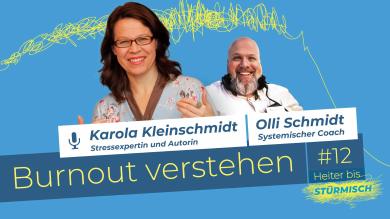
Chronic stress: working in alarm mode
Chronic stress is not an individual problem - it has long been a key risk factor for health, productivity and corporate culture. HR managers in particular are now faced with the challenge of taking preventative action. How an appreciative working environment, psychological safety and clear communication can help to break through the constant stress - and why healthy employees are the key to resilience in the company.
Read more in this article:
- What is chronic stress?
- What are the causes of chronic stress?
- How anxiety and chronic stress are connected
- Stress reaction: the body on alert
- How chronic stress makes you ill
- Symptoms of chronic stress
- Diseases caused by chronic stress
- What helps with chronic stress?
- 9 tips: What can employers do to combat chronic stress?
- Health as the key to a stable working environment
What is chronic stress?
We are all familiar with acute stress: a tingling sensation in the pit of the stomach, a sudden adrenaline rush and nervous sweats before an important presentation. Our body is designed to deal with such challenges, resolve them and then relax again.
However, there are also stressors that are not so easy to get rid of. Instead, more and more people are experiencing constant pressure that doesn't let up and causes lasting damage to the body and mind - chronic stress.
What are the causes of chronic stress?
Social and economic uncertainties are increasingly shaping the lives of people in Germany. The rising cost of living, social division and global crises such as the war in Ukraine are increasing the sense of threat. Employees in particular are feeling the effects: The fear of job loss or financial shortages leads to constant stress. Added to this is the rapid change in the world of work due to digitalization, artificial intelligence (AI) and growing competitive pressure.
How anxiety and chronic stress are connected
According to Swiss Life Germany's Stress Study 2024, 58% of Germans feel stressed due to their fear of war, political crises and social unrest, while 42% feel stressed by financial worries and the fear of social decline. A third of respondents feel stressed because they are unable to find an appropriate balance between work and private life in their everyday lives.
A study conducted by Headspace in 2023 sheds light on work-related anxiety with worrying results. More than half of German employees (59%) feel anxious about work at least once a week, with 17% even feeling anxious every day. The fear of having to take on even more responsibility at work was the biggest concern for employees (47%). 46% stated that they were bothered by the feeling of a lack of stability and the worry that something could happen. Another 46% fear that they will not be able to meet the expectations placed on them. Almost 40 percent feel threatened by artificial intelligence and/or fear for their job.
Stress reaction: the body on alert
These real fears, which are currently having a concentrated effect on us, primarily cause one thing: great stress! Our body feels threatened. It goes on alert to avoid potential danger.
The body reacts with evolutionary protective mechanisms:
- Heartbeat and breathing accelerate,
- Muscles tense up,
- Body and mind are in a state of constant tension,
- the concentration is focused on the threat.
"When we are under stress, our gaze becomes more focused. We then give our full attention to the problem so that we can solve it well. However, if it is a situation that lasts a long time or cannot be resolved, this focused view tends to be a hindrance. We are no longer able to see the big picture. That's why it's helpful in such a moment if someone pulls us out of autopilot mode so that we can widen our view again."
Psychologist and life coach Derya Bobrik
How chronic stress makes you ill
Around two thirds of Germans sometimes or often feel stressed(Statista, 2024). However, not all stress is the same: while positive stress (eustress) helps us to cope with challenges and can boost our performance, negative stress (distress) has long-term detrimental effects on our health - especially if it becomes chronic.
Persistent stress (chronic stress) occurs when the body is under constant tension over a long period of time. This can permanently lead to exhaustion, difficulty concentrating and even serious physical problems or mental illnesses such as depression, burnout or anxiety disorders.
In 2021, mental illnesses led to the most sick days and accounted for 21.8% of total absences. They were therefore ahead of musculoskeletal disorders and respiratory diseases. On average, an employee was on sick leave for more than 3 days this year due to a mental disorder(TK Health Report 2022).
According to Statista, almost half of those surveyed in 2021 said that their job was the main cause of their stress levels. The most common stress factors included high workloads, deadline pressure, interruptions and the merging of work and private life.

Symptoms of chronic stress
There are cognitive, emotional, physical and behavioral signs of chronic stress. "Not all four of these categories of symptoms have to occur in one person," says Rajita Sinha, PhD, director of Yale Medicine's Interdisciplinary Stress Center. "But if someone has three to five of these symptoms over several weeks, they could be suffering from chronic stress."
- Pain and discomfort
- Insomnia or drowsiness
- Change in social behavior, e.g. emotional withdrawal
- Low energy
- Lack of concentration or cloudy thinking
- Change in appetite
- Increased alcohol or drug consumption
- Change in emotional reactions to others
Diseases caused by chronic stress
Chronic stress is associated with other mental and physical illnesses. These can include
- Diseases such as high blood pressure, cardiovascular disease, gastrointestinal problems, obesity and metabolic syndrome, type II diabetes and arthritis
- Addiction to alcohol, nicotine and/or prescription drugs as well as behavioral addictions such as internet, food or gambling addiction
- Mood disorders and anxiety disorders, which are common secondary diagnoses in people with chronic stress
- High blood pressure, depression, addiction and anxiety disorders are the illnesses most strongly associated with chronic stress.
What helps with chronic stress?
Effective stress management is essential for a healthy and balanced life. Make sure you take regular breaks and schedule offline time to replenish your energy reserves and recover from the flood of information. Exercise promotes the release of endorphins (happiness hormones) as well as maintaining social contacts. Activities that give you pleasure create a valuable balance to stressful everyday life and contribute to your well-being.
- Time management
Improve your time organization: Create a list of your most important tasks and set priorities. Delegate where possible and reduce unimportant tasks. - Exercise and a healthy diet
Incorporate regular exercise into your daily routine by being active for at least 30 minutes a day. At the same time, make sure you eat a balanced diet and avoid unhealthy habits as much as possible to strengthen your body. - Time for a digital detox
Reduce the time you spend consuming negative news ("doomscrolling") and social media to protect yourself from being inundated with negative information. Schedule regular offline time to minimize stress. - Healthy sleep hygiene
Make sure you get enough sleep by developing a regular sleep routine. Create a quiet, dark sleeping environment to improve the quality of your sleep. Ban cell phones, computers, etc. from your bedroom to avoid disturbing your sleep. - Social support and open communication
Seek contact with friends and family and talk openly about your worries and fears. Do activities that you enjoy. A supportive social environment can help reduce chronic stress. - Mindfulness and relaxation techniques
Practice mindfulness exercises and relaxation techniques such as yoga or meditation to calm the mind and reduce stress. Use breathing exercises such as the 4-7-8 breathing exercise to calm down in stressful situations. - Professional help and individual solutions
Don't be afraid to seek professional support if the stress becomes overwhelming.
9 tips: What can employers do to combat chronic stress?
Companies can actively contribute to strengthening the mental health of their employees. After all, a healthy mind in a healthy body is not only personally beneficial, but also the basis for a resilient and sustainable working environment. An appreciative working environment and targeted measures in occupational health management can help to reduce mental stress:
- Have open conversations: Employees should feel safe to talk about their fears and stresses.
- Adjust workload: Clear task structures and realistic objectives help to avoid excessive demands.
- Offer stress management programs: Workshops on mindfulness, resilience and stress management can provide relief.
- Enable flexible working models: Working from home and flexible working hours can reduce stress.
- Offer psychological support: Company doctors or external counseling services can help.
- Promote a healthy corporate culture: Regular feedback, recognition and appreciative communication are crucial.
- Especially in change processes, but also otherwise: clear objectives and perspectives give employees security and reduce stress caused by anxiety.
- Healthy error culture: Dealing well with things that go wrong creates psychological security in the team, which in turn reduces the general stress level.
- Focus on strengths instead of problems: Create a working environment in which your employees can consciously use their strengths. Studies show that people experience less stress this way and have better mental hygiene.
Health as the key to a stable working environment
In a world full of uncertainty, it is crucial that companies actively invest in the mental health of their employees. A supportive working environment that responds to the needs of employees can not only reduce individual stress, but also contribute to a more resilient and healthier society. Only with a healthy mind and body can we master the challenges of the modern working world.







.jpg/5677f85a-7480-d07b-98b8-9096d134ca61/5677f85a-7480-d07b-98b8-9096d134ca61?imageThumbnail=2)


